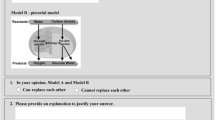Abstract
The purpose of this study was to compare the effects of using two- and three-dimensional model representations of molecular structures on student learning of organic chemical structures. Organic structures were taught to high school students using one of four methods of molecular representation: (1) two-dimensional textbook representations, (2) three-dimensional computer models, (3) three-dimensional ball and stick models, and (4) combination of the computer molecular models and the ball and stick models. The computer software used in this study wasMolecular Editor. Students in the combination group of using both computer and ball and stick models scored significantly higher on the retention test of isomeric identification compared to the other groups. Molecules were represented in this test in the same mode as the instructional representation. However, on a similar two-dimensional post-instructional test of isomeric identification, this group had a significantly lower mean than the other groups; the two-dimensional group had the highest mean. This difference was not observed with the two-dimensional retention test of isomeric identification. When given a two-dimensional test of isomeric construction, no significant difference was found among the group means with either the posttest or the retention test.
Similar content being viewed by others
References
Bobbert, L. C. (1982). The effects of using interactive computer simulated laboratory experiments in college chemistry courses.Dissertation Abstracts International, 43, 07A.
Gabel, D., and Sherwood, R. (1980). The effect of student manipulation of molecular models on chemistry achievement according to Piagetian level.Journal of Research in Science Teaching, 17(1), 75–81.
Goodstein, M., and Howe, A. (1978). The use of concrete methods in secondary chemistry instruction.Journal of Research in Science Teaching, 15(5), 361–366.
Kagan, H. (1979).Organic stereochemistry, John Wiley and Sons, New York.
Lindsay, P. H. and Norman, D. A. (1977).Human information processing: An introduction to psychology (2nd ed.). Academic Press, New York.
Lipkowitz, K. (1984). Molecular models in the organic chemistry laboratory.Journal of Chemical Education, 61(12), 1051–1052.
Paivio, A. (1986).Mental representations: A dual coding approach. Oxford University Press, New York.
Piaget, J. (1963).Psychology of intelligence. Littlefield, Adams and Co., Paterson, New Jersey.
Piaget, J. and Inhelder, B. (1956).The child's conception of space, F. J. Langdon and J. L. Lunzer, Translators. The Humanities Press, New York.
Pribyl, J., and Bodner, G. (1987). Spatial ability and its role in organic chemistry: A study of four organic courses.Journal of Research in Science Teaching, 24(3), 229–240.
Rochford, K. (1987).Students' visual learning disabilities and under-achievement in selected science subjects. Paper presented at the Annual Convention of the Council for Exceptional Children, Chicago, Illinois. ERIC Document Reproduction Service No. ED 290 275.
Rozzelle, A. A., and Rosenfeld, S. M. (1985). Stereoscopic projection in organic chemistry.Journal of Chemical Education, 62(12), 1084–1085.
Rumelhart, D. E. (1977).Introduction to human information processing. John Wiley and Sons, New York.
Seddon, G. M., and Shubber, K. E. (1984). The effects of presentation mode and colour in teaching the visualisation of rotation in diagrams of molecular structures.Research in Science and Technological Education, 2(2), 167–176.
Shepard, R., and Chipman, S. (1970). Second order isomorphism of representations: Shapes of states.Cognitive Psychology, 1, 1–17.
Small, M. Y., and Morton, M. E. (1983). Spatial visualization training improves performance in organic chemistry.Research in College Science Teaching, September/October, 41–43.
Sowell, E. (1989). Effects of manipulative materials in mathematics instruction.Journal for Research in Mathematics Education, 20, 498–505.
Talley, L. (1973). The use of three-dimensional visualization as a moderator in the higher cognitive learning of concepts in college level chemistry.Journal of Research in Science Teaching, 10(3), 263–269.
Tuckey, H., Selvaratnam, M., and Bradley, J. (1991). Identification and rectification of student difficulties concerning threedimensional structures, rotation, and reflection.Journal of Chemical Education 68(6), 460–464.
Winn, J. S. (1987). Molecular Editor.Journal of Chemical Information and Computer Sciences, 27(3), 143–144.
Wise, K. C. (1984). The impact of microcomputer simulations on the achievement and attitude of high school physical science students.Dissertation Abstracts International, 44, 2432A.
Wise, K. C., and Okey, J. R. (1983). A meta-analysis of the effects of various science teaching strategies on achievement.Journal of Research in Science Teaching, 20(5), 419–435.
Yamana, S. (1989). An easily constructed bicapped trigonal prism model.Journal of Chemical Education, 66(12), 1021–1022.
Author information
Authors and Affiliations
Rights and permissions
About this article
Cite this article
Copolo, C.E., Hounshell, P.B. Using three-dimensional models to teach molecular structures in high school chemistry. J Sci Educ Technol 4, 295–305 (1995). https://doi.org/10.1007/BF02211261
Issue Date:
DOI: https://doi.org/10.1007/BF02211261




